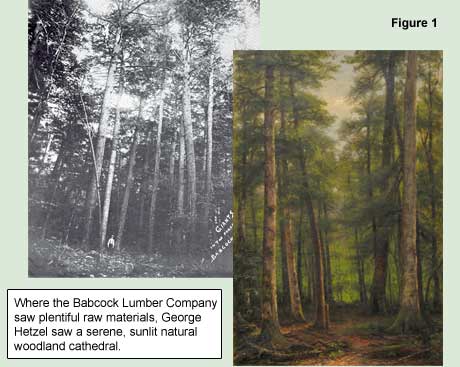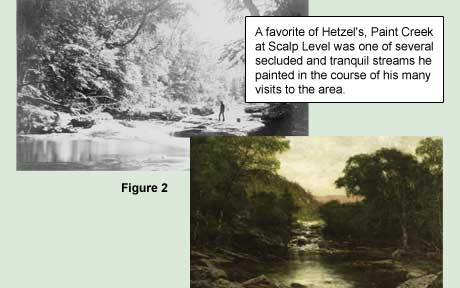On the train from Pittsburgh to Johnstown, a slightly-built man with a large nose and a full beard puffed contentedly on his pipe as he gazed out the windows at the deep green forest of pine, hemlock, maple and oak. Large stone outcroppings appeared between thickets of rhododendron and mountain laurel, and the sunlight filtered gently down to the forest floor. He looked forward to another wonderful summer of relaxing with friends, fishing, and painting the beautiful woodland landscape of Scalp Level in western Pennsylvania.
The man was George Hetzel, an accomplished Pittsburgh artist and a teacher at the Pittsburgh School of Design for Women. After first seeing the Scalp Level area in 1866, he strongly encouraged his colleagues at the School of Design, as well as his other artist friends, and his daughter Lila and her friends, to accompany him each summer to this enchanting area of mountain streams and deep green hills. Hauling canvases, painting supplies, and fishing tackle on the train, and then by rented wagon, to the area where Paint Creek and Little Paint Creek meet, they rented cottages or boarded with local inhabitants for several months each year. The small sketches and studies they produced “en plein air”---on site and directly from nature--- would later be enlarged into handsome finished paintings showcasing the beauty of this pristine natural area.

George Hetzel’s art school years in Dusseldorf, Germany (1847-48) had awakened his interest in landscape painting, and like the Hudson River School painters, to whom they are often compared, the Scalp Level painters used dramatic lighting and deep shadow to convey the almost religious quality of the untouched landscape. In the last third of the 19th century, Pittsburgh and other cities were becoming more heavily industrialized, and artists sought to remind the public of what was being lost. In addition to Hetzel, Pittsburgh artists such as Clarence Johns, Jasper Lawman, Trevor McClurg, brothers Alfred S. Wall and William C. Wall, Charles Linford, Joseph Woodwell, and later A.F. King, Martin B. Leisser, Horatio S. Stevenson, Lila B. Hetzel, George Layng, Olive Turney, A. Bryan Wall, Bessie Wall, John Wesley Beatty, E. A. Poole, Laura Rinehart, Agnes Way, and Annie Henderson returned to the area repeatedly to record the forests, fields, streams, and farms that would later be replaced or by logging, mining, or other industries. By the early 1900s, as thousands of immigrant workers moved to the area to work in the mills and the mines, these industries transformed the landscape and left an environmental impact that is still being felt today.
The paintings themselves, reminders of those sunlit summer days, remain as a valued legacy in western Pennsylvania museums, where visitors can glimpse the idyllic world of the Scalp Level painters.

Back to Top
|
|


